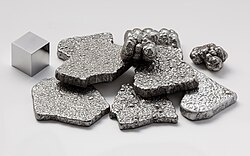|
|---|
| Metals [2] | Metalloids | Nonmetals [2] |
|---|
| Form and structure | |
| Colour | - nearly all are shiny and grey-white
- Cu, Cs, Au: shiny and golden [3]
| | - most are colourless or dull red, yellow, green, or intermediate shades [5]
- C, P, Se, I: shiny and grey-white
|
| Reflectivity | - intermediate to typically high [6] [7]
| | - zero or low (mostly) [10] to intermediate [11]
|
| State of matter at STP | | | |
| Density | | | |
| Deformability (as a solid) | | | - often brittle
- some (C, P, S, Se) have non-brittle forms [n 4]
|
| Poisson's ratio [n 5] | | - low to intermediate [n 7]
| - low to intermediate [n 8]
|
| Crystalline structure at freezing point [41] | | | - H, He, C, N, Se: hexagonal
- O, F, Ne, P, Ar, Kr, Xe, Rn: cubic
- S, Cl, Br, I: orthorhombic
|
| Packing & coordination number | - close-packed crystal structures [42]
- high coordination numbers
| - relatively open crystal structures [43]
- medium coordination numbers [44]
| - open structures [45]
- low coordination numbers
|
Atomic radius
(calculated) [46] | - intermediate to very large
- 112–298 pm, average 187
| - small to intermediate: B, Si, Ge, As, Sb, Te
- 87–123 pm, average 115.5 pm
| - very small to intermediate
- 31–120 pm, average 76.4 pm
|
| Allotropes [47] [n 9] | - around half form allotropes
- one (Sn) has a metalloid-like allotrope (grey Sn, which forms below 13.2 °C [48] )
| - all or nearly all form allotropes
- some (e.g. red B, yellow As) are more nonmetallic in nature
| |
| Electron-related |
| Periodic table block | | | |
| Outer s and p electrons | - few in number (1–3)
- except 0 (Pd); 4 (Sn, Pb, Fl); 5 (Bi); 6 (Po)
| | - high number (4–8)
- except 1 (H); 2 (He)
|
| Electron bands: (valence, conduction) | - nearly all have substantial band overlap
- Bi: has slight band overlap (semimetal)
| | |
| Electron behaviour | - "free" electrons (facilitating electrical and thermal conductivity)
| - valence electrons less freely delocalized; considerable covalent bonding present [51]
- have Goldhammer-Herzfeld criterion [n 10] ratios straddling unity [55] [56]
| - no, few, or directionally confined "free" electrons (generally hampering electrical and thermal conductivity)
|
| Electrical conductivity | | | |
| ... as a liquid [64] | - falls gradually as temperature rises [n 14]
| | - increases as temperature rises
|
| Thermodynamics |
| Thermal conductivity | | | - almost negligible [69] to very high [70]
|
| Temperature coefficient of resistance [n 15] | - nearly all positive (Pu is negative) [71]
| | - nearly all negative (C, as graphite, is positive in the direction of its planes) [74] [75]
|
| Melting point | | | |
| Melting behaviour | - volume generally expands [76]
| - some contract, unlike (most) [77] metals [78]
| - volume generally expands [76]
|
| Enthalpy of fusion | | - intermediate to very high
| - very low to low (except C: very high)
|
| Elemental chemistry |
| Overall behaviour | | | |
| Ion formation | | | |
| Bonds | - seldom form covalent compounds
| | - form many covalent compounds
|
| Oxidation number | | - positive or negative [84]
| |
| Ionization energy | | | |
| Electronegativity | | | |
| Combined form chemistry |
| With metals | | | |
| With carbon | | | |
| With hydrogen (hydrides) | | - covalent, volatile hydrides [93]
| - covalent, gaseous or liquid hydrides
|
| With oxygen (oxides) | | | |
| With sulfur (sulfates) | | | |
| With halogens (halides, esp. chlorides) (see also [119] ) | - typically ionic, involatile
- generally insoluble in organic solvents
- mostly water-soluble (not hydrolysed)
- more covalent, volatile, and susceptible to hydrolysis [n 22] and organic solvents with higher halogens and weaker metals [120] [121]
| - covalent, volatile [122]
- usually dissolve in organic solvents [123]
- partly or completely hydrolysed [124]
- some reversibly hydrolysed [124]
| - covalent, volatile
- usually dissolve in organic solvents
- generally completely or extensively hydrolyzed
- not always susceptible to hydrolysis if parent nonmetal at maximum covalency for period e.g. CF4, SF6 (then nil reaction) [125]
|
| Environmental chemistry |
| Molar composition of Earth's ecosphere [n 23] | - about 14%, mostly Al, Na, Mg, Ca, Fe, K
| | |
| Primary form on Earth | | | - elemental C, N, O, S, noble gases are plentiful
- H, [n 24] F [n 25] , Se occur primarily in compounds
- P, Cl, Br, I occur only in compounds, as phosphates, oxides, selenides or halides
|
| Required by mammals | - large amounts needed: Na, Mg, K, Ca
- trace amounts needed of some others
| - trace amounts needed: B, Si, As
| - large amounts needed: H, C, N, O, P, S, Cl
- trace amounts needed: Se, Br, I, possibly F
- only noble gases not needed
|
| Composition of the human body, by weight | - about 1.5% Ca
- traces of most others through 92 U
| | - about 97% O, C, H, N, P
- others detectable except noble gases
|



